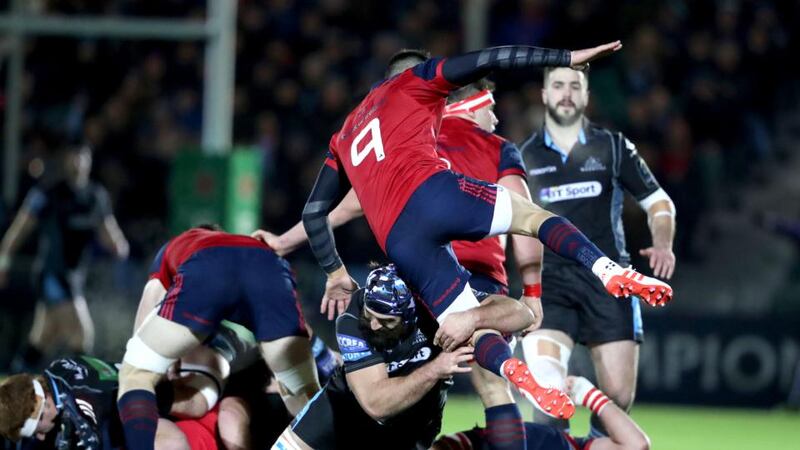The Munster performance in Glasgow looked very familiar. The game has changed dramatically in the past 10 years but that old directness, that control by the halfbacks, could have been plucked from any showing during those halcyon days in the 2000s.
The likes of Jim Williams, David Wallace, Denis Leamy and Anthony Foley were replaced with the same impact from CJ Stander, Jack O’Donoghue and Peter O’Mahony.
Conor Murray had a really good game despite the suspected concussion and Glasgow forwards honing in on him for a little extra examination.

Murray was, clearly, targeted. This shouldn't come as a surprise. Any team that wants to negate Munster and Ireland need to get to him.
There is no bigger compliment. This is not going to cease. Conor will go away and look at these incidents and refine his technique, ever so slightly, to ensure those diving at his standing leg do not injure him or disrupt his mindset.
I’m sure Rassie Erasmus will pull him aside and say ‘Welcome to the Big League.’ Erasmus won most of his 36 caps on the Springboks flank when Joost van der Westhuizen was the most dominant scrumhalf in the world.
Of course van der Westhuizen was singled out for special treatment.
The best nine in the game must be able to cope with cheap shots or little moments, like being held after play moves on.
It happens to all the great scrumhalves. I was fortunate enough to play for the Barbarians against England at Twickenham in 2009. Justin Marshall was at Saracens at this stage, at the tail end of a career that yielded 81 tests for the All Blacks, but the English backrow still managed to rattle him early on. They were grabbing him off the ball and just winding him up, because the likes of Dylan Hartley, Lewis Moody and Nick Easter knew this was the smartest route to disrupting any Baabaas rugby.
It didn’t work because Marshall kept his composure to ensure Iain Balshaw, myself (in purple Clongowes socks) and Rocky Elsom (at the end of his brilliant season in Dublin) all cut loose for tries in a 33-26 win.
It worked out well for me as a late call-up for the Lions tour of South Africa followed a few days later.
But none of that might have happened if a less composed scrumhalf was playing. It also helped that Marshall could depend on Jerry Collins and Serge Betsen for protection.
Such attention is the highest compliment an opposition can pay you. Glasgow didn’t become Pro12 champions two years ago by being a clean cut outfit. They know Murray is one of the key figures in Munster's game plan. His influence is potentially becoming more profound than CJ Stander, Simon Zebo, Jaco Taute or Tyler Bleyendaal.
Expect more of this in the Six Nations. Kieran Marmion and Luke McGrath are both showing serious form yet they remain some distance off the standard Murray is operating at this season. Every scrumhalf in the northern hemisphere, besides Danny Care for England in November, gets ranked below him now.
He can also expect constant attention from every Kiwi 'loosey' on the Lions tour this summer. By then I expect a return to the composure shown in Chicago, when he showed just how important he is to whichever team he is in.

The way the game went, Glasgow didn’t kick much, Murray was forced up from his usual sweeping role behind the defensive line to make more tackles – completing eight of ten - than usual. Again, this is something he's well capable of doing. He just got his head placement wrong for the Tim Swinson contact.
I don’t think he ever fully lost his composure. He just turned to the officials for support the second time he was flipped in the air after his standing leg was targeted. The referee and touch judges didn’t see it.
It was clever planning by Glasgow, so hard to notice in real time because the ball is up in the sky and just shy of a citing offence.
Alan Quinlan and Nathan Hines made a career out of slowing the progress of scrumhalves or whoever was near them as play moved on.
Munster and Leinster more than profited as a result. A little grab of the leg, in the heat of the moment might draw some retaliation, a swinging arm or even a kick.
The result? A penalty and possibly a yellow card for the victim!
Conor almost struck Strauss but managed to control himself.
There is a trade off with diving on a scrumhalf like this as the player can easily get a hoof in the face by the trailing leg.
Not every game will be like this. Glasgow knew that to beat Munster they would need to stop their kicking game at source.
To Murray’s credit, he still had the most influence in a huge victory for Munster on the road.
We also saw, over the weekend, and this will continue, that yellow cards are coming due the pressure heaped on defences. Incidents like Stuart Hogg’s sin-binning, which led indirectly to Francis Saili’s match winning try a few moments later, can only be good for the game because they reward attacking rugby and create that extra bit of space on the pitch.
I’ve been in the exact same situation as Hogg at Leinster training before Andrew Conway moved to Munster. His exceptional footwork could have you falling on your ass every day.

It was a lazy arm by Hogg but it begs the question: can we find the medium in these calls?
I think the officials got it right. They learned from last week's poor judgement of awarding the Scarlets a penalty try and yellow card for Ulster’s Sean Reidy.
A sin-binning for Hogg and penalty was the correct decision as Conway failed to ground the ball but will that be the case after the Six Nations? Hogg’s glancing arm on Conway was accidental. There will be two or three of these a game as players dip for the try line.
Right now, referees are leaning heavily on the rule book with every contact above the shoulders leading to a yellow or red card. Andrew cleanly stepped Hogg and was caught with a hardly malicious trailing arm.
If that is going to be considered reckless than we can expect a numerical advantage in every game.
Nathan Grey, the Waratahs and Wallabies defence coach, who knows a thing or two about big tackles, told the Sydney Morning Herald that he is already prepping his players to survive when down to 14 or even 13 players ahead of the Super Rugby season.
I think in time we can find a better balance with new terminology. If, say, the referee sees a trailing “soft” arm he can perhaps rule out recklessness.
The refs still need more time to adjust, just like the players are slowly adapting at the moment.
Frans Steyn, on the other hand, has no grounds to defend his sending off because there was intent in his late tackle on Johnny Sexton.
I have already written a column about Sam Cane’s hit on Robbie Henshaw and how the responsibility is on the tackler, and where he lines up the point of contact.
Yes, Johnny caught the ball low and dipped his right knee before passing but the contact was late and Steyn clearly went to flatten him. One step earlier and Steyn might have made a brilliant and legitimate tackle that could have rattled Johnny within the laws of the game.
In November, there was enormous consternation around a similar collision. Now there is none. That’s a victory for the law makers.
However, Montpellier seemed intent on hurting Johnny with their huge lock Paul Willemse smashing him late a few minutes before Steyn's attempt.
Like Murray, Sexton is well aware that this treatment will come when he attacks the gainline before releasing Robbie Henshaw.
It’s up to the TMO or officials to protect these players.
Steyn had to go. And in the current climate it was a red card. It was probably a yellow before January 3rd and the sanction could return to that if the law is relaxed closer to the summer.
We shall see.
In the meantime, players like Steyn and Cane have to change the way they enter contact.
Wade through all these barely controversial moments from the weekend and we have Leinster, Munster and conceivably Connacht all just one victory away from a home quarter-final.
I don’t think anyone saw this, before October, in what has been a remarkable turnaround for Irish rugby.
Munster are all but certain to beat Racing 92 at home but I can’t see Connacht getting out of Toulouse with a victory or even a losing bonus point.
I’d be happy to be wrong should these eternal underdogs defy the odds once again.
Castres is a deceptively tough place to go. Leinster struggled down there under Matt O'Connor. I remember it because it was where I exacerbated the injury that opened the door for Robbie Henshaw to wear the 12 jersey for Ireland.
You arrive into a ghost town the day before and could be fooled into a relaxed, sleepy mindset but come a few hours before kick-off the locals create a serious match day intensity in and around Stade Pierre-Antoine.
Also, unlike the bigger French clubs, Castres have a smaller largely native squad so the same 20-25 players are always used for home matches.
Leinster, even in their current form, will have to replicate their consistency and possibly a little more to circumnavigate a home performance driven by pride.
It’s as important a fixture as any this season because a home quarter-final is an essential pathway for almost any successful European campaign.
















